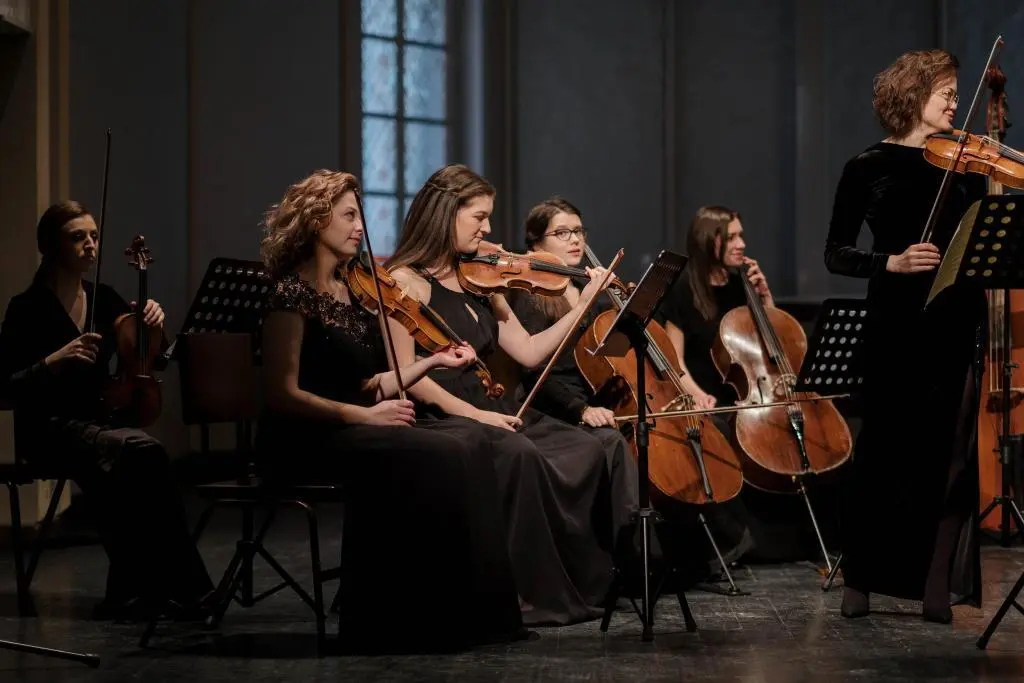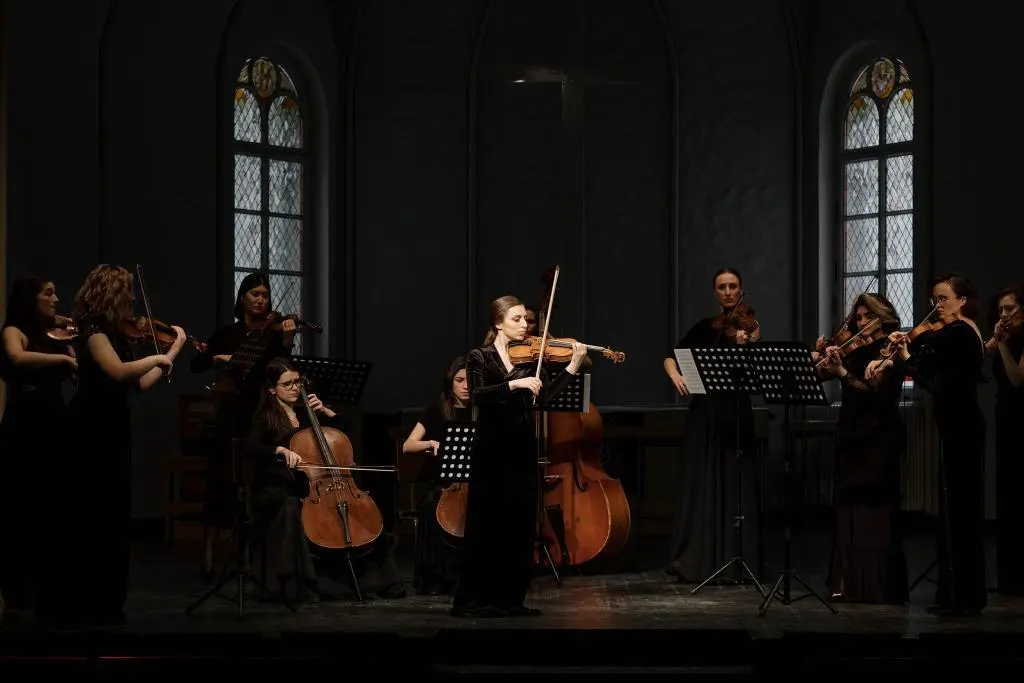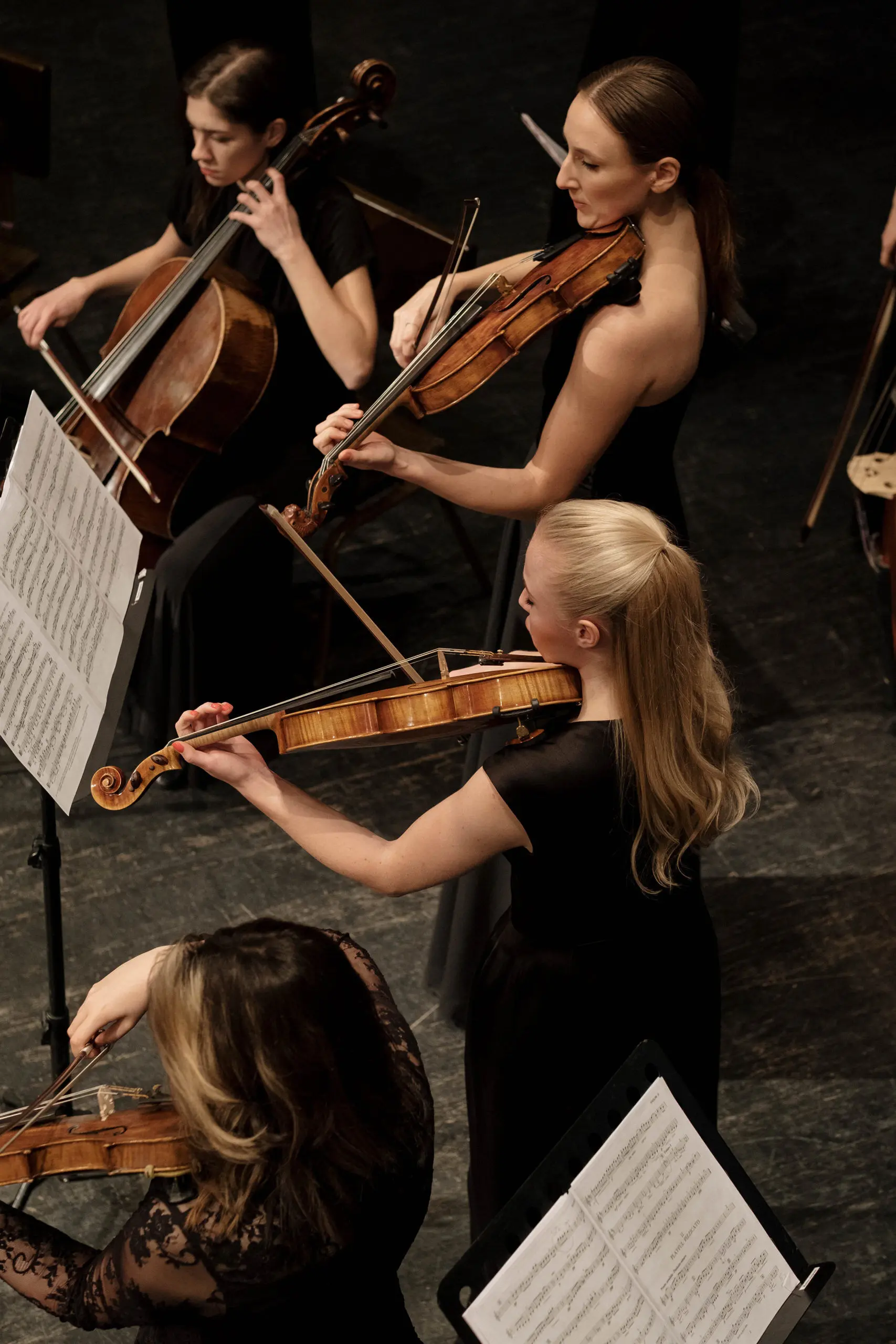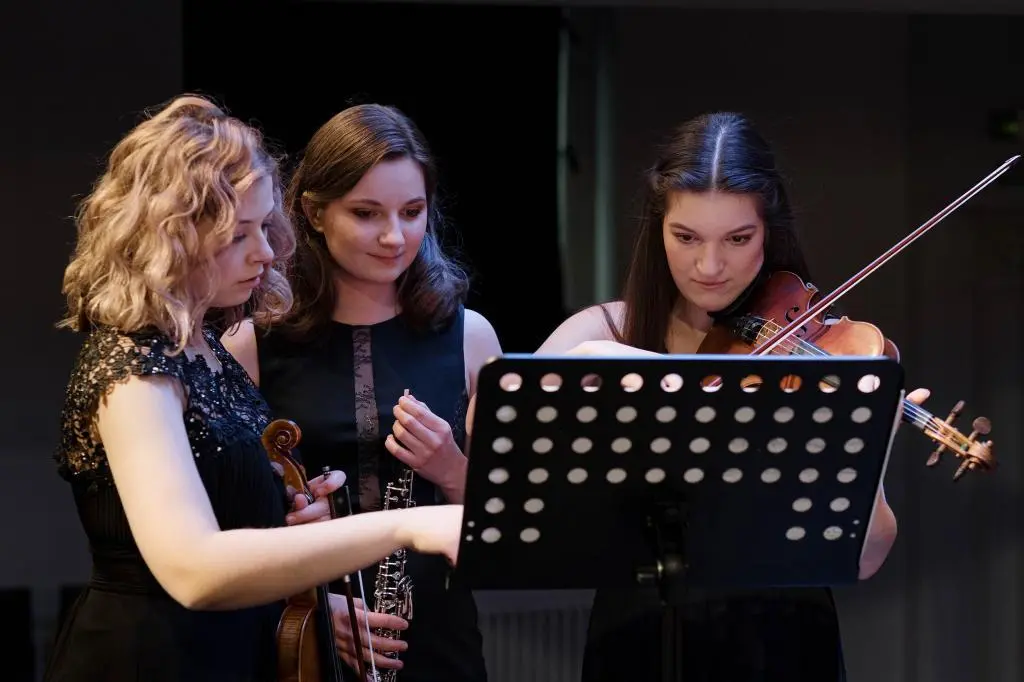A music ensemble is simply a group of musicians playing together. It could be as small as two people or as large as a full-blown orchestra.
Music is a vast and colorful world. From foot-tapping jazz to soul-stirring classical, there’s a style for everyone. And within these styles, it’s often groups of musicians, or ensembles, that bring the melodies to life. Think of your favorite band or the choir at a holiday event; these are all examples of ensembles.

What is Music Ensemble: Table of Contents
So, what’s the big deal about the term ‘ensemble’? In music lingo, it’s all about teamwork. It’s not just one person playing an instrument or singing; it’s a group working together to create a harmonious sound. It’s like a sports team, where everyone has a role, and they all work together to score points.
Now, why should we care about music ensembles? Well, they’re a big part of the music we hear and love. From famous bands on the radio to orchestras in movies, ensembles are everywhere. They shape the music industry, bring fresh sounds to our ears, and remind us of the beauty of teamwork.

History of Music Ensembles
Evolution of Ensembles
The journey of music ensembles is as rich and varied as the history of music itself. From the ancient civilizations to the modern era, ensembles have been the lifeblood of musical expression.
In the early days, music was primarily a communal activity. Think of tribes gathering around a fire, with each member contributing a beat, a clap, or a voice. These were the first ensembles, where music was a collective effort. As societies evolved, so did the complexity of these groups. The Greeks had their choruses, the Romans had their brass bands, and the Middle Ages saw the rise of choral groups in religious settings.
The Renaissance period was a game-changer for music ensembles. Instruments like the lute, harpsichord, and early versions of the violin came into play. Musicians began to group based on the instruments they played, leading to the formation of orchestras and chamber music groups.
Fast forward to the 20th century, and the world witnessed the explosion of band culture. From jazz bands in smoky clubs to rock bands in massive arenas, ensembles took center stage in shaping the music industry.
Cultural Influence on Ensembles
Culture and music are deeply intertwined, and this relationship has played a pivotal role in shaping the concept of music ensembles. Different cultures have their unique take on ensembles, each adding a distinct flavor to the global music potpourri.
Take Africa, for instance. The continent is renowned for its drum circles, where each drummer plays a specific rhythm, creating a layered, intricate sound. This ensemble style is deeply rooted in African traditions and has influenced genres like jazz and hip-hop.
In Asia, the ensemble culture is diverse. China’s traditional orchestras, with instruments like the erhu and pipa, offer a stark contrast to the gamelan ensembles of Indonesia, which rely heavily on percussive sounds.
Europe, with its rich musical history, has given the world iconic ensembles like the symphony orchestra, stemming from its classical music traditions. Meanwhile, Latin America has its salsa and mariachi bands, ensembles that are synonymous with vibrant rhythms and passionate melodies.

What Is A Music Ensemble?
Defining ‘Ensemble’
At its core, an ensemble is about unity and collaboration. In the world of music, this term takes on a special resonance. A music ensemble refers to a group of musicians who come together to create harmonious soundscapes. It’s not just about individual prowess but the collective magic that emerges when diverse musical talents converge.
Imagine a puzzle. Each piece, unique in its shape and design, fits perfectly with others to create a complete picture. Similarly, in a music ensemble, each musician, with their distinct style and instrument, collaborates to produce melodies that strike a chord with the audience. Whether it’s the synchronized strumming of guitars, the harmonious blend of a choir, or the rhythmic beats of a drum circle, it’s the ensemble that brings these sounds to life.
Types of Ensembles
Now, when we delve deeper into the realm of music ensembles, we find a rich tapestry of types and forms, each with its distinct characteristics.
- Vocal Ensembles: As the name suggests, these are groups where the human voice is the primary instrument. From duets and trios to choirs and a cappella groups, vocal ensembles showcase the versatility and range of the human voice. Whether it’s the soulful renditions of a gospel choir or the intricate harmonies of a barbershop quartet, vocal ensembles have a unique charm that resonates deeply with listeners.
- Instrumental Ensembles: These are groups where instruments take center stage. Think of orchestras with their violins and cellos, jazz bands with saxophones and trumpets, or rock bands with guitars and drums. Each musician in an instrumental ensemble plays a specific role, contributing to the overall sound and feel of the music.
- Combined Ensembles: A beautiful fusion of voices and instruments, combined ensembles offer the best of both worlds. Examples include opera companies, where singers and orchestras come together, or folk bands, where vocal melodies intertwine with instrumental rhythms. These ensembles are a testament to the limitless possibilities in music when diverse talents collaborate.

The Different Types Of Music Ensembles
Categorizing Music Ensembles
The world of music ensembles is as diverse as the melodies they produce. Just as a painter uses a variety of brushes to create different strokes, musicians come together in various groupings to bring distinct sonic experiences to life. To truly appreciate the depth and range of music ensembles, it’s essential to understand their categorization.
At a broad level, music ensembles can be classified based on their size and the type of music they produce. However, diving deeper, we realize that the categorization is much more nuanced. From the number of members to the instruments they play, several factors come into play.
- Large Ensembles: These are the powerhouses of the music world. Comprising a significant number of members, large ensembles are known for their grandeur and depth of sound. Imagine the majestic sound of a symphony orchestra, with its violins, cellos, horns, and percussion, all playing in perfect harmony. Or the vibrant energy of a big jazz band, where saxophones, trumpets, and trombones come together to create foot-tapping rhythms. Large ensembles are all about creating a rich tapestry of sounds, where each musician contributes to the collective melody.
- Small Ensembles: Intimate and versatile, small ensembles offer a more personalized musical experience. These groups, often comprising two to ten members, are known for their flexibility and adaptability. Think of the soulful melodies of a string quartet or the playful banter between instruments in a jazz trio. Small ensembles allow for closer interactions between musicians, leading to spontaneous improvisations and unique soundscapes. Whether it’s the romantic duets of a violin and cello or the lively rhythms of a percussion trio, small ensembles bring a fresh perspective to the music.
Large Ensembles
The world of music ensembles is vast, and among the most captivating are the large ensembles. These groups, with their multitude of members and instruments, create soundscapes that are both grand and immersive. Let’s delve into some of the most iconic large ensembles and understand their unique characteristics.
Concert Band
Characteristics of a Concert Band
A concert band, often referred to as a wind ensemble, primarily consists of woodwind, brass, and percussion instruments. Unlike an orchestra, it typically lacks stringed instruments like violins or cellos. Instruments you might find in a concert band include flutes, clarinets, trumpets, trombones, and tubas, among others. The beauty of a concert band lies in its ability to produce a wide range of tones and dynamics, from the soft melodies of a clarinet to the powerful beats of a bass drum.
Jazz Band
Anatomy of a Jazz Band
Jazz, with its soulful melodies and foot-tapping rhythms, owes much of its charm to the jazz band. A typical jazz band is a melting pot of instruments, with saxophones, trumpets, trombones, and rhythm sections comprising pianos, bass, and drums. What sets jazz bands apart is their emphasis on improvisation. While there might be a basic structure or melody, musicians often go off-script, adding their unique flair and style, making each performance distinct.
Marching Band
Unique Features of Marching Bands
Marching bands are a spectacle, both audibly and visually. While they share several instruments with concert bands, what sets them apart is their mobility. Marching bands perform on the move, often accompanying parades, football games, and other events. Their music is more rhythmic, designed to keep pace with their steps. Additionally, they often incorporate color guards and majorettes, adding a visual element to their performance.
Chamber Orchestra
Dive into Chamber Orchestras
A chamber orchestra is like a mini symphony. Comprising a smaller group of musicians, usually between 15 to 40, chamber orchestras focus on playing classical compositions written specifically for smaller ensembles. You’ll find string instruments like violins, violas, cellos, and basses, complemented by a few woodwinds or brass, depending on the composition. The intimate size allows for a closer connection between the musicians, leading to a more cohesive sound.
Symphony (Philharmonic) Orchestra
Symphony vs. Philharmonic
When it comes to grandeur in the world of music ensembles, few can match the majesty of a symphony or philharmonic orchestra. Both terms often refer to large-scale orchestras that play symphonic music. The primary difference? The name “philharmonic” simply means “loving music” and is often used to differentiate between two major orchestras in a city. These orchestras boast a vast array of instruments, from strings, woodwinds, and brass to percussion. The sheer number of musicians, often upwards of 100, allows for a depth and richness of sound that is truly unparalleled.
Small Ensembles
While large ensembles offer a grand and immersive musical experience, small ensembles bring an intimacy and precision that’s equally captivating. These groups, often comprising just a handful of musicians, showcase the beauty of collaboration in its purest form. Let’s delve into the world of small music ensembles and explore their unique characteristics.
Octet
Understanding Octets
An octet is a music ensemble consisting of eight musicians or eight distinct musical voices. The combination of instruments can vary, but a classic example is Schubert’s Octet in F major, which includes a clarinet, bassoon, horn, two violins, a viola, cello, and double bass. The beauty of an octet lies in its balance, with each instrument adding a layer of depth and richness to the overall sound.
Septet
Dive into Septets
A septet is, as the name suggests, a group of seven musicians. One famous example is Beethoven’s Septet in E-flat major, which features a violin, viola, cello, double bass, clarinet, bassoon, and horn. The septet offers a harmonious blend of string and wind instruments, creating a sound that’s both full-bodied and intricate.
Sextet
Features of a Sextet
A sextet comprises six musical voices or instruments. The composition can vary, but a common lineup might include two violins, two violas, and two cellos, as seen in Brahms’ String Sextet No. 1. The sextet format allows for a rich interplay between instruments, with each one shining while also contributing to the ensemble’s collective melody.
Quintet
Quintet in Focus
A quintet is a music ensemble of five members. One classic example is Schumann’s Piano Quintet, which features a piano, two violins, a viola, and a cello. Quintets can be versatile, with the combination of instruments varying based on the genre and the composer’s vision.
Quartet
Exploring Quartets
Arguably one of the most recognized small ensembles, a quartet consists of four musicians. The string quartet, with two violins, a viola, and a cello, is a popular configuration. Quartets offer a close-knit harmony, with each instrument playing a crucial role in shaping the ensemble’s sound.
Trio
Trio Dynamics
A trio is a group of three musicians. Common configurations include the piano trio, with a piano, violin, and cello, or the string trio, with a violin, viola, and cello. Trios are all about synergy, with each member bringing their unique flair to the ensemble, resulting in a sound that’s both cohesive and dynamic.
Duet
The Beauty of Duets
At its simplest, a duet is a performance by two musicians. This could be two vocalists, two instrumentalists, or a combination of both. Duets are intimate, allowing for a deep connection between the performers. From the romantic duets in operas to the synchronized melodies of guitar duos, duets showcase the beauty of collaboration in its purest form.
Make Your Own Ensemble
Crafting Unique Ensembles
In the vast universe of music, there’s always room for innovation. Why stick to the traditional when you can craft something uniquely yours? Creating your own music ensemble is not just about gathering musicians; it’s about envisioning a sound that’s distinctively yours.
Remember, there’s no strict rulebook when it comes to music ensembles. Want a trio with a violin, a saxophone, and a djembe? Go for it! Dreaming of a quartet that blends classical with jazz? Why not? The beauty of music lies in its boundless possibilities. So, embrace the flexibility of ensemble compositions. Experiment with different instruments, genres, and sounds. Sometimes, the most unexpected combinations lead to the most mesmerizing melodies.
Ensemble Creation Guide
Here’s a step-by-step guide to help you on this exciting journey:
- Vision First: Before anything else, define your ensemble’s vision. What kind of music do you want to create? What unique sound do you want to bring to the table?
- Find Your Tribe: Look for musicians who share your passion and vision. Remember, technical prowess is essential, but so is chemistry.
- Experiment and Jam: Before finalizing your ensemble, have a few jam sessions. Feel the vibe, understand each other’s style, and see if you all sync well.
- Define Roles Clearly: Ensure every member knows their role and responsibility. Clarity is crucial to avoid future conflicts.
- Practice, Practice, Practice: Like any other team, a music ensemble gets better with practice. Dedicate time to rehearse regularly.
- Stay Open to Feedback: Constructive criticism is a growth catalyst. Encourage a culture where members can give and receive feedback positively.
- Celebrate Small Wins: Every gig, every applause, every fan is a step forward. Celebrate these moments; they fuel the journey ahead.
Lastly, remember that forming an ensemble is just the beginning. The real magic lies in the journey you embark on together, the challenges you overcome, and the melodies you create.
Navigating the Ups and Downs of Music Ensembles
Tackling Ensemble Hurdles
Being part of a music ensemble is like embarking on an adventurous journey. Sure, there are moments of harmony and joy, but there are also bumps along the way. Yet, with the right mindset and tools, these challenges can be turned into growth opportunities.
1. The Ego Tug-of-War: When you bring together a group of talented individuals, it’s only natural that there might be a few clashes. Everyone has their unique flair and vision, which can sometimes lead to spirited debates.
- Solution: Build a foundation of mutual respect. Celebrate each other’s strengths and be willing to find middle ground. After all, the magic of an ensemble lies in its unity.
2. The Scheduling Puzzle: Juggling personal lives, individual gigs, and group rehearsals can feel like trying to solve a complex puzzle.
- Solution: Plan ahead and maybe even consider modern scheduling apps. It’s all about finding a rhythm that works for everyone.
3. The Quest for Consistency: Making sure everyone’s on the same musical page isn’t always easy.
- Solution: Practice makes perfect. Consider recording rehearsals to pinpoint and work on any inconsistencies.
4. Money Matters: Covering the costs of rehearsals, equipment, and promotions can sometimes strain the group’s resources.
- Solution: Think outside the box. Crowdfunding campaigns, sponsorships, or even intimate gigs can help boost the ensemble’s funds. And always, transparency is key.
5. Navigating Creative Differences: Different opinions on a piece or performance direction? It’s all part of the ensemble experience.
- Solution: Foster an environment where everyone feels their voice is valued. Sometimes, an outside perspective or facilitator can help bridge any gaps.
6. Tech Troubles: Technical hiccups, from equipment malfunctions to venue sound issues, can throw a wrench in the works.
- Solution: Be prepared. Regular equipment checks and pre-performance soundchecks can help avoid last-minute surprises.
Remember that these challenges are just part of the journey. Overcoming them not only refines the group’s sound but also strengthens its bond. So, to all ensemble enthusiasts, embrace the challenges, cherish the harmonies, and keep making beautiful music together!

